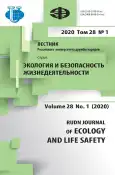Philosophy of ecology of Justus von Liebig: different Liebig
- Authors: Nikolskii A.A.1, Vanisova E.A.1
-
Affiliations:
- Peoples’ Friendship University of Russia (RUDN University)
- Issue: Vol 28, No 1 (2020)
- Pages: 75-81
- Section: Ecology
- URL: https://journal-vniispk.ru/2313-2310/article/view/323879
- DOI: https://doi.org/10.22363/2313-2310-2020-28-1-75-81
- ID: 323879
Cite item
Full Text
Abstract
German chemist Justus von Liebig is known in the ecological literature as the author of “Liebig’s law of the minimum”. But the law of the minimum is absent in his publications, which ecologists cite. The “law” is nothing more than an interpretation of some of Liebig’s statements. However, irrespective of the law of the minimum, Liebig’s outstanding contribution to the theory of ecology is obvious: Liebig was one of the first who drew attention to the sustainability of the phenomenon of life organized into supraorganismal systems. Liebig showed that as a result of the interaction of plants and animals and as a result of their life processes, such as nutrition and respiration, there is a continuous transformation of a substance consisting of the same elements. On the example of the constancy of the gas composition of the atmosphere, Liebig comes to a generalization that is crucial for ecology: the interaction of plants and animals is a factor of sustainability of their own environment, which they create themselves and support for an unlimited time in a stable state.
About the authors
Alexander A. Nikolskii
Peoples’ Friendship University of Russia (RUDN University)
Author for correspondence.
Email: bobak@list.ru
Doctor of Biological Sciences, Professor, Professor of the Department of System Ecology of Faculty of Ecology
6 Miklukho-Maklaya St, Moscow, 117198, Russian FederationElena A. Vanisova
Peoples’ Friendship University of Russia (RUDN University)
Email: vanhelen@mail.ru
PhD in Biological Sciences, Associate Professor of the Department of System Ecology of Faculty of Ecology
6 Miklukho-Maklaya St, Moscow, 117198, Russian FederationReferences
- Pryanishnikov DN. Razvitie vzglyadov na pitanie rastenii i rol' Libikha v sozdanii sovremennogo ucheniya ob udobrenii [Development of views on plant nutrition and the role of Liebig in creating modern doctrine of fertilizer]. In: Liebig J. Khimiya v prilozhenii k zemledeliyu i fiziologii [Chemistry in its applications to agriculture and physiology]. Мoscow, Leningrad: Sel'hozgiz Publ.; 1936. p. 5-27. (In Russ.)
- Shilov IA. Ekologiya [Ecology]: textbook for biological and medical specialties of universities. Мoscow: Vysshaya shkola Publ.; 1997. (In Russ.)
- Liebig J. Organic chemistry in its applications to agriculture and physiology. London: Taylor and Walton; 1840.
- Liebig J. Principles of agricultural chemistry: with special reference to the late researches made in England. New York: John Willey; 1855.
- Odum EP. Fundamentals of Ecology. 3rd ed. Philadelphia, London, Toronto: W.B. Saunders Company; 1971.
- Nikol’skii AA. Velikie idei velikikh ekologov: istoriya klyuchevykh kontseptsii v ekologii [The great ideas of the great ecologists: history of key concepts in ecology]. Мoscow: GЕОS Publ.; 2014. (In Russ.)
- Haeckel E. Generelle Morphologie der Organismen. Bd. 1, 2. Berlin: Verlag von Georg Reimer; 1866.
- Tansley AG. The use and abuse of vegetational concepts and terms. Ecology. 1935; 16(3):284-307.
- Liebig J. Die organische Chemie in ihrer Anwendung auf Agricultur und Physiologie. Braunschweig: F. Vieweg und Sohn; 1840.
- Liebig J. Khimiya v prilozhenii k zemledeliyu i fiziologii [Chemistry in its applications to agriculture and physiology]. Saint Petersburg: Tipografiya Fridrikha Fivega i syna v Braunshveige; 1864. (In Russ.)
- Liebig J. Khimiya v prilozhenii k zemledeliyu i fiziologii [Chemistry in its applications to agriculture and physiology]. Мoscow, Leningrad: Sel'hozgiz Publ.; 1936. (In Russ.)
- Fedorov VD, Gil'manov TG. Ekologiya [Ecology]. Moscow: Izd-vo Moskovskogo universiteta Publ.; 1980. (In Russ.)
- Phelan PL. Ecology-Based Agriculture and the Next Green Revolution. In: Bohler PJ, Houser G. (eds.) Sustainable Agroecosystem Management: Integrating Ecology, Economics and Society. London, New York: CRC Press; 2009. p. 98-136.
- Shelford VE. The reactions of certain animals to gradients of evaporating power of air: a study in experimental ecology. Biological bulletin. 1913;25(2):79-120.
- Shvarts SS. Teoreticheskie osnovy i printsipy ekologii [Theoretical foundations and principles of ecology]. Sovremennye problemy ekologii: doklady Pyatoi Vsesoyuznoi ekologicheskoi konferentsii [Modern problems of ecology: reports of the Fifth All-Union Environmental Conference]. Мoscow: Izd-vo Moskovskogo universiteta Publ.; 1973. p. 21-31. (In Russ.)
- Volterra V. Variazioni e fluttuazioni del numerodi’ individui in specie animali conviventi. Mem. R. Accad. Naz. Dei Lincei. Ser. VI. 1926;2:3-113.
- Lotka AJ. The growth of mixed populations: two species competing for a common food supply. Journ. Wash. Ac. Sci. 1932;22 (2):461-469.
- Gause GF. Experimental studies on the struggle for existence. I. Mixed population of two species of yeast. Journ. Exp. Biol. (British). 1932;9:389-402.
- Gause GF. The Struggle for Existence. Baltimore: The Williams and Wilkins Company; 1934.
- Hutchinson GE. Concluding remarks. Cold Spring Harbor Symposia on Quantitative Biology. 1957;22 (2):415-427.
Supplementary files









